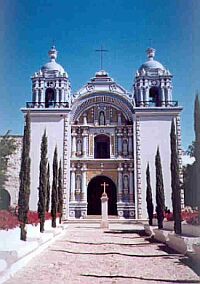
This is the first of 14 churches and ex-convents in the municipio (like a county) of Ocotlan, that are being restored through the good graces of painter and community servant Rodolfo Morales. [Photo by Diana Ricci]
|
Much of Mexico is poverty-stricken, but only in economic terms. There is a richness of spirit here. Whether in the oral tradition of the isolated indigenous villages or the written and visual repositories of the cities, there is a wealth of historical and cultural continuity reaching back to before most Europeans crawled out of their cave dwellings. This year, as every year in May, one of Oaxaca's premier art galleries hosts an exhibition which by all accounts could never ever happen in the U.S.A. This event provides a unique insight into Mexican culture.

This is the first of 14 churches and ex-convents in the municipio (like a county) of Ocotlan, that are being restored through the good graces of painter and community servant Rodolfo Morales. [Photo by Diana Ricci] |
This arrangement is just one of the many ways in which the government -- federal, state and local -- invests in the creative energies of the people. Oaxaca -- as do virtually all state capitals -- has a symphony orchestra and a concert band. There are museums of contemporary and folk art, auditoriums, concert halls, research libraries and outdoor performance arenas. Almost every town of any size has a Casa de la Cultura (house of culture). Performers, composers, artists and artisans work under contract or as freelancers in projects paid for by the government. Hundreds of support staff -- ticket takers, poster makers, custodians, electricians, publicists -- work for the ministries of culture which are charged with Making Art Happen. As in our country, salaries are not adequate. Musicians employed by the state symphony have to take in students in order to survive. Lithographers who display their works in the Museum do framing to bring in extra cash. Nonetheless, competition is fierce and - with the usual exception for nepotism or political influence - the rewards, however inadequate, keep some of the best of them working at their art.
As in every country, artists tend to move around in search of work, display space, and stipends. Many of the musicians who play in the Oaxaca orchestra are from Jalisco and Vera Cruz, and some Oaxacans perform in the National Opera in Mexico City. One violist is a visiting gringo who sits in -- without pay -- during the four months he spends here every winter. A few Oaxacans have become world-famous. They show in New York, Paris and Tokyo; they have prestigious agents; and they have returned home to share their good fortunes with their vecinos (neighbors). On a good day, Rodolfo Morales dresses like a reasonably comfortable small town businessman; on a bad day like a bum. Barrel chested and middle aged, dressed in a flannel shirt and cloth pants, his mustache and hair worn longish and shaggy, his appearance betrays nothing of his tremendous talent or his financial status. In his home town of Ocotlan de Morelos, near Oaxaca city, everyone knows Maestro (master, teacher) Rodolfo. He is a town hero, not just for his accomplishments but for his modesty, his involvement in the community, and his private and public generosity. The gallery mentioned above, does business in a building in the center of Oaxaca that is owned by Rodolfo. He maintains a studio and apartment above and behind the courtyard, on the third floor. Under his personal supervision, the building, in need of restoration when he bought it, has provided a model which other wealthy Oaxacans follow: that it is better to restore the past than to tear it down and build "modern" buildings.
Rodolfo owns a house in his native Ocotlan de Morelos, near Oaxaca city. He restored its old colonial charm. The entire ground floor is furnished with wonderful 18th and 19th century furniture and artifacts. There is a brass plate outside the front door: Casa de la Cultura (house of culture). It is run by and for the State of Oaxaca. Classes are held there, and community meetings. Upstairs, there is a computer classroom, where local youth are taught the skills of the future on the newest machines available. The home and grounds are open to the public.
There is a very old church in downtown Ocotlan. It had fared poorly since the anti-clerical period which followed the Revolution of 1910-1919. Rodolfo paid to have it restored. Part of his restoration plan calls for local young women to be hired as restoration assistants and taught skills that will enable them to be gainfully employed in the trade.
Next to the church is the old convent. Over the last 70 years, it has served many purposes, the last as a prison. It is now a municipal facility, housing performance spaces, meeting rooms, and other public functions, thanks to Rodolfo's vision and generosity. Like Rodolfo, Tamayo and Toledo and countless others have left a legacy of art, architecture and public space for present and future generations to enjoy. The synergy of giving and getting is not perfect, and some who deserve don't get, and some who have gotten don't give. But what is left is magnificent, and inspiring, and a treat for the senses. It is, in the best sense of the word, civilized: both civil and civic. (June, 1996)